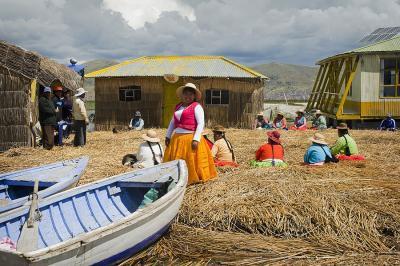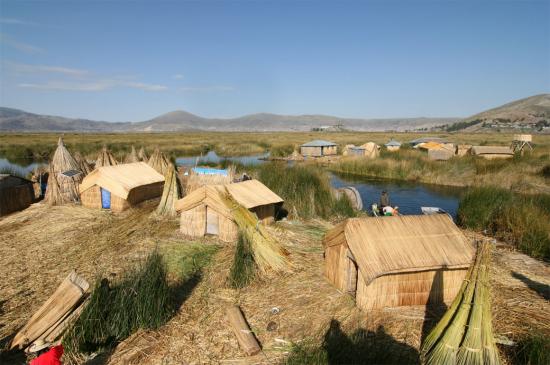Source http://www.pasthorizonspr.com/index.php/archives/09/2013/uros-people-found-to-have-distinctive-genetic-ancestries
New genetic research led by the Genographic Project consortium shows a distinctive ancestry for the Uros populations of Peru and Bolivia that pre-dates the arrival of the Spanish conquistadores and may date back to the earliest settlement of the Altiplano, or high plain, of the central Andes some 3,700 years ago.
Despite the fact that the Uros today share many lineages with the surrounding Andean populations, they have maintained their own divergent genetic ancestry.

Community gathering on one of the Uros Islands on the Peruvian side of Lake Titicaca. Image: Eduardo Rubiano
The Uros are a self-identified ethnic group, about 2,000 of whom live in Peru, many of them on artificial floating islands on Lake Titicaca. Another 2,600 individuals live beside lakes and rivers of Bolivia. According to some anthropologists, the Uros are descendants of the first settlers of the Altiplano — the Andean plateau — yet their origin has been subjected to considerable academic debate.
Target of discrimination
Those from Peru have long claimed to descend from the ancient Urus (Uruquilla speakers), using their differentiated ethnic identity to assert rights and prerogatives for their use of Titicaca’s natural resources. The Uros have historically been the target of discrimination by the pre-Inca, Inca and the Spanish, and this continues today. Some people have alleged that the Uros disappeared a long time ago and that the new islanders have conjured up an ancient heritage in order to attract tourists and receive special recognition and rights.
“The timing of human settlement in the Andean Altiplano is one of the great mysteries of our species’ worldwide odyssey — a vast, high-altitude plain that seems utterly inhospitable, yet it has apparently nurtured a complex culture for millennia,” said Spencer Wells, Genographic Project director and National Geographic Explorer-in-Residence.
Representatives of the Genographic Project, compared the Uros’ haplotype (genetic lineages) profiles with those of eight Aymara-, nine Quechua- and two Arawak-speaking populations from the western region of South America.

Uros reed houses. Image: Emre Safak (Wikimedia, used under a CC BY-SA 3.0)
Confined to floating islands and small villages
The Andean highlands are home to a vast indigenous population of several million, mostly Aymaras and Quechuas. The Uros are a minority group that consider themselves descendants of the ancient Urus, who are generally recognized as the first major ethnic group to have settled in the Andes, specifically the Lake Titicaca watershed. As a result of successive invasions by Aymara populations and the Incas, an increasing proportion of the Uros became confined to floating islands and small villages around the lake.
Today, the Uros of Peru and Bolivia are also known as Qhas Qut suñi, which means “people of the lake” in the ancient Uruquilla language. Their economy was originally based on aquatic resources, especially fishing, bird hunting and gathering of bird eggs. Using the lake’s reeds for construction of islands, houses and handicrafts for tourism, the Uros have become a fascination to visitors, and the Altiplano is now Peru’s second most important tourist destination.
Source: National Geographic Society